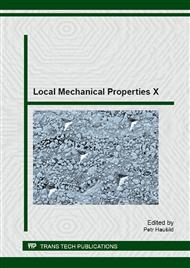[1]
J. Maynard, Resonant Ultrasound Spectroscopy, Phys. Today. 49 (1996) 26-31.
Google Scholar
[2]
R.G. Leisure, F.A. Willis, F.A. Resonant Ultrasound Spectroscopy, J. Phys. Condens. Matter 9 (1997) 6001-6029.
DOI: 10.1088/0953-8984/9/28/002
Google Scholar
[3]
E.K.H. Salje, M.A. Carpenter, G.F. Nataf, G. Picht, K. Webber, J. Weerasinghe, S. Lisenkov, L. Bellaiche, Elastic excitations in BaTiO3 single crystals and ceramics: Mobile domain boundaries and polar nanoregions observed by resonant ultrasonic spectroscopy. Phys. Rev. B 87 (2013).
DOI: 10.1103/physrevb.87.014106
Google Scholar
[4]
Y. Danis, C. Arvieu, E. Lacoste, T. Larrouy, J. -M. Quenisset, An investigation on thermal, metallurgical and mechanical states in weld cracking of Inconel 738LC superalloy. Mater. Design 31(2010) 402-416.
DOI: 10.1016/j.matdes.2009.05.041
Google Scholar
[5]
M. Kabla, H. Seiner, M. Musilová, M. Landa, D. Shilo, The relationships between sputter deposition conditions, grain size, and phase transformation temperatures in NiTi thin films, submitted to Acta Mater.
DOI: 10.1016/j.actamat.2014.02.009
Google Scholar
[6]
V.M. Segal, Materials processing by simple shear. Mater. Sci. Eng. A, 197 (1995) 157-164.
Google Scholar
[7]
M. Janeček, S. Yi, R. Král, J. Vrátná, K.U. Kainer, Texture and microstructure evolution in ultrafine-grained AZ31 processed by EX-ECAP, J. Mater. Sci. 45(2010) 4665-4671.
DOI: 10.1007/s10853-010-4675-1
Google Scholar
[8]
J. Vrátná, M. Janeček, J. Čížek, D.J. Lee, E.Y. Yoon, H.S. Kim, Mechanical properties and microstructure evolution in ultrafinegrained AZ31 alloy processed by severe plastic deformation, J. Mater. Sci. 48(2013) 4705–4712.
DOI: 10.1007/s10853-013-7151-x
Google Scholar
[9]
J. Vrátná, B. Hadzima, M. Bukovina, M. Janeček, Room temperature corrosion properties of AZ31 magnesium alloy processed by extrusion and equal channel angular pressing, J. Mater. Sci. 48(2013) 4510-4516.
DOI: 10.1007/s10853-013-7173-4
Google Scholar
[10]
H. Watanabe, T. Mukai, M. Sugioka, K. Ishikawa, Elastic and damping properties from room temperature to 673 K in an AZ31 magnesium alloy, Scripta Mater. 51 (2004) 291–295.
DOI: 10.1016/j.scriptamat.2004.04.032
Google Scholar
[11]
H. Seiner, L. Bodnárová, P. Sedlák, M. Janeček, O. Srba, R. Král, M. Landa, Application of ultrasonic methods to determine elastic anisotropy of polycrystalline copper processed by equal-channel angular pressing, Acta Mater. 58 (2010) 235-247.
DOI: 10.1016/j.actamat.2009.08.071
Google Scholar


